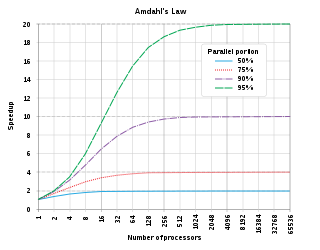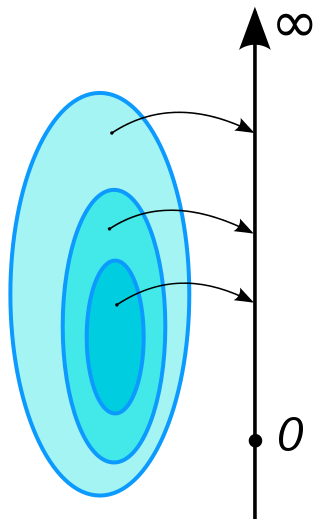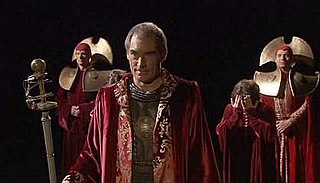
In computer architecture, Amdahl's law is a formula that shows how much faster a task can be completed when you add more resources to the system.

In mathematics, the concept of a measure is a generalization and formalization of geometrical measures and other common notions, such as magnitude, mass, and probability of events. These seemingly distinct concepts have many similarities and can often be treated together in a single mathematical context. Measures are foundational in probability theory, integration theory, and can be generalized to assume negative values, as with electrical charge. Far-reaching generalizations of measure are widely used in quantum physics and physics in general.

The Moving Picture Experts Group (MPEG) is an alliance of working groups established jointly by ISO and IEC that sets standards for media coding, including compression coding of audio, video, graphics, and genomic data; and transmission and file formats for various applications. Together with JPEG, MPEG is organized under ISO/IEC JTC 1/SC 29 – Coding of audio, picture, multimedia and hypermedia information.
Velars are consonants articulated with the back part of the tongue against the soft palate, the back part of the roof of the mouth.

A lymph node, or lymph gland, is a kidney-shaped organ of the lymphatic system and the adaptive immune system. A large number of lymph nodes are linked throughout the body by the lymphatic vessels. They are major sites of lymphocytes that include B and T cells. Lymph nodes are important for the proper functioning of the immune system, acting as filters for foreign particles including cancer cells, but have no detoxification function.

The medulla oblongata or simply medulla is a long stem-like structure which makes up the lower part of the brainstem. It is anterior and partially inferior to the cerebellum. It is a cone-shaped neuronal mass responsible for autonomic (involuntary) functions, ranging from vomiting to sneezing. The medulla contains the cardiovascular center, the respiratory center, vomiting and vasomotor centers, responsible for the autonomic functions of breathing, heart rate and blood pressure as well as the sleep–wake cycle. "Medulla" is from Latin, ‘pith or marrow’. And "oblongata" is from Latin, ‘lengthened or longish or elongated'.

Provinces are the most numerous type of province-level divisions in the People's Republic of China (PRC). There are currently 22 provinces administered by the PRC and one province that is claimed, but not administered, which is Taiwan, currently administered by the Republic of China (ROC).

The frontal lobe is the largest of the four major lobes of the brain in mammals, and is located at the front of each cerebral hemisphere. It is parted from the parietal lobe by a groove between tissues called the central sulcus and from the temporal lobe by a deeper groove called the lateral sulcus. The most anterior rounded part of the frontal lobe is known as the frontal pole, one of the three poles of the cerebrum.

The Allegheny Plateau is a large dissected plateau area of the Appalachian Mountains in western and central New York, northern and western Pennsylvania, northern and western West Virginia, and eastern Ohio. It is divided into the unglaciated Allegheny Plateau and the glaciated Allegheny Plateau.

Thomas Say was an American entomologist, conchologist, and herpetologist. His studies of insects and shells, numerous contributions to scientific journals, and scientific expeditions to Florida, Georgia, the Rocky Mountains, Mexico, and elsewhere made him an internationally known naturalist. Say has been called the father of American descriptive entomology and American conchology. He served as librarian for the Academy of Natural Sciences of Philadelphia, curator at the American Philosophical Society, and professor of natural history at the University of Pennsylvania.

Theriiformes is a clade of mammals. The term was coined by Timothy B. Rowe in his doctoral dissertation, and is defined as the clade formed by the most recent common ancestor of multituberculates and Theria. Mammals more closely related to therians than to multituberculates are included in the clade Trechnotheria. As multituberculates are usually considered more closely related to therians than monotremes are, it is considered to be a subgroup of the mammalian crown group.
Moronene is an Austronesian language spoken in Bombana Regency, Southeast Sulawesi, Indonesia. It belongs to the Bungku–Tolaki branch of the Celebic subgroup.
Greenwood Publishing Group, Inc. (GPG), was an educational and academic publisher which was part of ABC-Clio. Since 2021, ABC-Clio and its suite of imprints, including GPG, are collectively imprints of British publishing house Bloomsbury Publishing. The Greenwood name stopped being used for new books in 2023.

In mathematics, the Riemann hypothesis is the conjecture that the Riemann zeta function has its zeros only at the negative even integers and complex numbers with real part 1/2. Many consider it to be the most important unsolved problem in pure mathematics. It is of great interest in number theory because it implies results about the distribution of prime numbers. It was proposed by Bernhard Riemann, after whom it is named.
The fundamental theorem of calculus is a theorem that links the concept of differentiating a function with the concept of integrating a function. Roughly speaking, the two operations can be thought of as inverses of each other.

"The End of Time" is a two-part story of the British science fiction television series Doctor Who, originally broadcast in the United Kingdom on BBC One on 25 December 2009 and 1 January 2010. It is the fifth Doctor Who Christmas special and the last entry in a series of specials aired from 2008 to 2010. It marks the final regular appearance of David Tennant as the Tenth Doctor and introduces Matt Smith as the Eleventh Doctor. At the time, it was the last Doctor Who story written and produced by Russell T Davies, who shepherded the series' return to British television in 2005 and served as the series's executive producer and chief writer, until he returned to the position in 2022 for the 60th anniversary specials onwards.
The National Heritage List for England (NHLE) is England's official database of protected heritage assets. It includes details of all English listed buildings, scheduled monuments, register of historic parks and gardens, protected shipwrecks, and registered battlefields. It is maintained by Historic England, a government body, and brings together these different designations as a single resource even though they vary in the type of legal protection afforded to them. Although not designated by Historic England, World Heritage Sites also appear on the NHLE; conservation areas do not appear since they are designated by the relevant local planning authority.
Homoadelphoceras is a genus of gyroconic rutoceratid Nautiloid from the Middle Devonian of central Europe. Whorls not in contact, venter and dorsum,, broadly rounded. Dorso-lateral and ventro-lateral flanks more or less flat, meet at an angle.
A uniform resource locator (URL), colloquially known as an address on the Web, is a reference to a resource that specifies its location on a computer network and a mechanism for retrieving it. A URL is a specific type of Uniform Resource Identifier (URI), although many people use the two terms interchangeably. URLs occur most commonly to reference web pages (HTTP/HTTPS) but are also used for file transfer (FTP), email (mailto), database access (JDBC), and many other applications.











